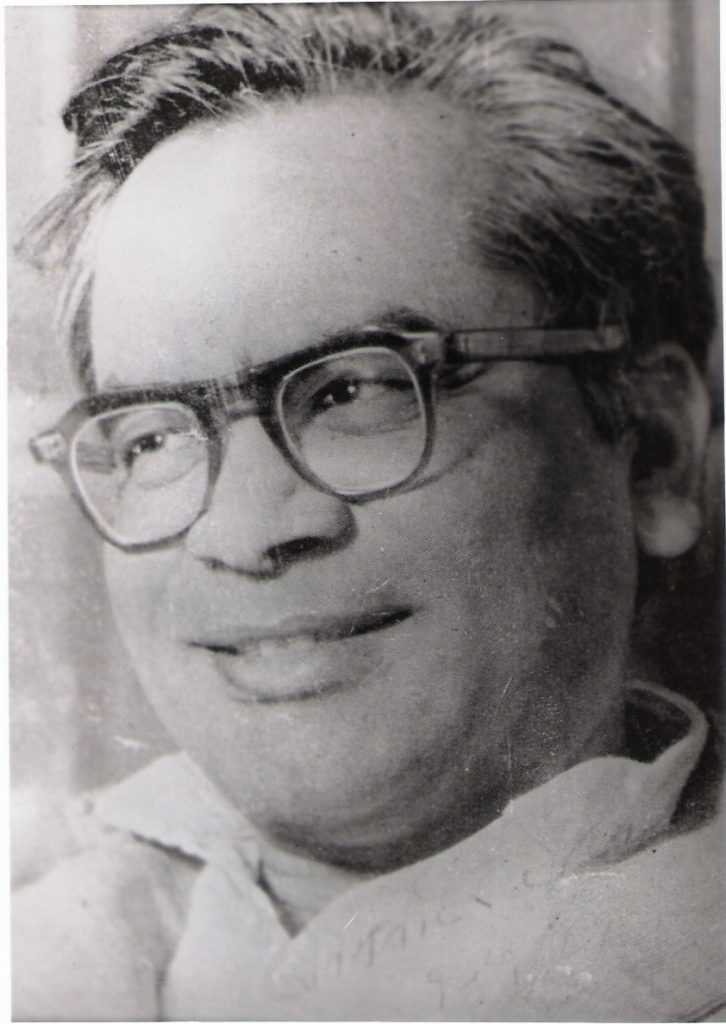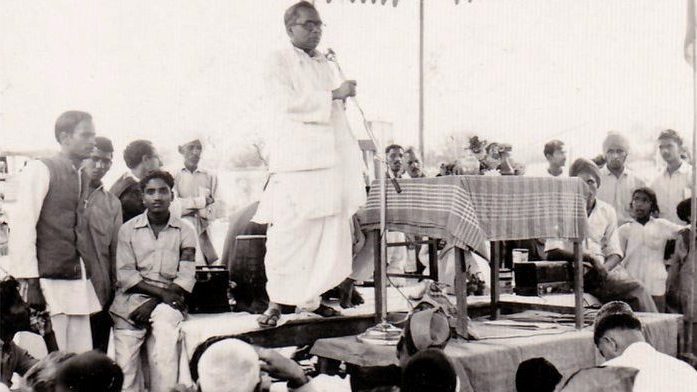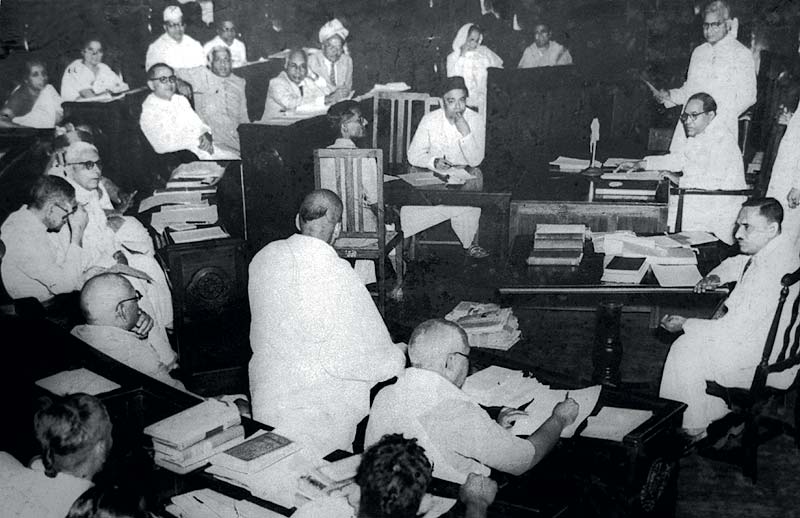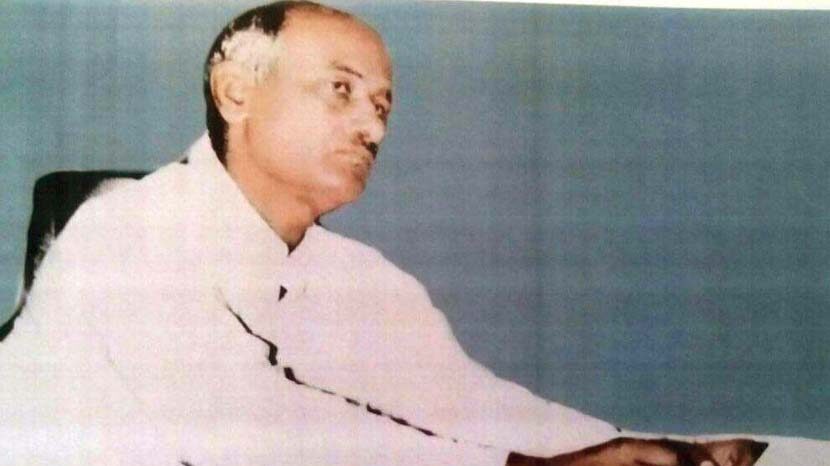Har jor julm ke takkar mein sangharsh hamara nara hai
(Let us take up a struggle against every oppression and every injustice)
– Dr Ram Manohar Lohia

As a historian, politician, social activist and freedom fighter, Rammanohar Lohia brought a multidimensional perspective to his visions of social reform and national progress. When considered as a whole, Lohia’s politics reveals a nuanced engagement with a wide range of issues concerning India’s future after independence. A strong critic of Western capitalism, Lohia considered himself a revolutionary who employed Marxist insights and socialist means to achieve a Gandhian vision of social harmony and self-sufficiency. He was protective of India’s territorial integrity while making a plea for international peace and cooperation. He sought a modern India that was free from religious superstition and bigotry though he did not hesitate to criticize the pre-eminent status that was given to English and sought to remedy this situation by advocating the widespread adoption of indigenous languages. Lohia railed against the caste system as the most evil of traditional practices while also highlighting the British administration’s hand in nurturing caste-based hierarchies. Across the vast range of his opinions, Lohia emerges as a figure willing to straddle both modern and traditional styles of thinking as long as they served the ends of social justice and national upliftment.
A future free of caste and gender hierarchies
In 1944, Lohia was imprisoned in Lahore Fort where he was subjected to physical torture as punishment. There, he adopted a philosophical attitude, viewing the present as a period of transition where difficulties could be borne but working towards one’s vision and dreams for the nation’s future with a determination that the same compromises should not be made. This attitude towards the future permeated his political initiative (Yadav 2009). In his visions of progress, Lohia greatly differed from social reformers like Raja Ram Mohan Roy and Mahadev Govinda Ranade who interpreted ancient traditions in the light of modern Western ideas.

Though Lohia was an atheist he was not against religion per se (Mehrotra 1978). He sought a harmonious relationship between religion and politics, one in which “religion is long-term politics and politics is short-term religion”. For Lohia, religion ought to accomplish the greater good just as politics had to be concerned with fighting evil. He lamented the state of religion in India where it was still the preserve of pandits and mullahs who used it to control the lower classes whereas there were examples of countries which, as a result of various religious reform movements, had managed to confine religion to the private sphere. Lohia wanted the Indian mind “to have patience to hear criticisms of Rama or Mohammad”. Criticism, according to him, should not “spill blood or burn books”. Lohia in his introduction to “Guilty Men of India’s Partition” pointed out that the sugary sentimentalism which characterized religious belief should be replaced by a calm appraisal of religious doctrines and faith in order to assess what aspects of religious belief and doctrine were worth retaining so that a discussion could begin over what aspects of religion needed to be discarded. The stories of Ram, Krishna and Shiva fascinated him, but he also denounced fanatical devotees of Ram as wife-banishers, those of Krishna as thieves and those of Shiva as carrion lovers (Mehrotra 1978). The painter M.F. Husain recalls how Lohia encouraged him to be free with his Ramayana and Mahabharata paintings, as the myths did not belong to a particular faith (Yadav 2010). Free from the strictures of traditional authorities, Lohia trained his keen eye on the inequalities of the caste system.

Unlike many of his contemporaries, Lohia did not dismiss (and thereby ignore) the insidious roots of the caste system and its oppressive effects on India’s social reality. For him, to stop talking of caste was to shut one’s eyes to the most powerful of India’s social institutions; “One does not end caste merely by wishing it away,” said Lohia. He questioned a belief widely held by progressive movements that economic equality would bring caste equality. He pointed out that the upper castes occupied four-fifths of the top leadership of the key sectors of the nation – business, army, civil services and political parties. Lohia also did not agree with the prevailing historical narrative that internal quarrels and intrigues were the cause of India’s conquest by foreign powers. He argued that “(n)ot disunity, but caste has been the prime factor behind India’s susceptibility to invasions and her frequent submission to them”.

Unlike Ambedkar, Lohia saw the hand of the British behind the strengthening and perpetuation of the system of castes and so did not want any nature of compromise with the British administration. He held that foreign rule, while accentuating and widening differences, did not constitute them given that the traditional institution of caste remained the primary marker of difference. Lohia found it “meaningless to talk of equality while maintaining the caste system. Classlessness is impossible without castelessness. The Bania lords the nation’s belly, the Brahmin lords the nation’s mind.” It is necessary to qualify Lohia’s views on casteism by adding that he is surprisingly silent on the caste system’s fundamental role in Hinduism. Here, unlike Ambedkar, his views are not explicit and he appears to be toeing the line of Gandhi, who thought that the caste system was just a distorted aspect of Hinduism. Lohia also differed with Ambedkar on the question of Adivasis. While the latter considered them uncivilized people living in savage conditions, for Lohia, they were essential partners in the crusade against caste. Lohia accused Ambedkar of being sectarian in his arguments and urged him to become a leader of all Indians and not just those belonging to the Scheduled Castes (Lohia 1964: 19, 36-7). Though Lohia agreed with Gandhi on some aspects of caste, he also recognized the danger of the latter’s romantic depiction of caste where the Varnashram ideal was upheld.

Lohia was not satisfied with the system of reservation designed to provide opportunities for the lower castes as he believed it did not go far enough, especially when it came to advancing the position of women, Harijans, Shudras, depressed Muslims and Christians, and Adivasis. As he saw it, these particularly disadvantaged groups that constituted 90 per cent of the population should have been assured of at least 60 per cent of all educational opportunities (with exceptions being made for specialized skills as surgery). Aside from legal protections such as reservations, Lohia believed that in order for the social attack on caste to not be “single-barreled” it should include grass-roots movements in rural areas that encouraged the mass adoption of inter-dining and inter-caste marriages. Lohia believed that there was a split personality among Hindus who believed in the virtues of the caste system. His argument that the caste system was a bundle of contradictions was anticipated by D.D. Kosambi, the Marxian historian who argued that the average Hindu was like a python that assimilates contradictions without attempting to resolve them (Patnaik 2009). Lohia saw the oppression of the caste system in tandem with socially enforced gender hierarchies.
In contrast to the masculinist pressures of his time, Lohia used to consider himself part man and part woman. In his preface to Marx, Gandhi and Socialism, Lohia held that the inequality between the sexes was at the root of every injustice. He observed that the participation of women in collective life was exceedingly limited, even in countries like Russia and America which claimed to have achieved equality between the sexes. Lohia was convinced that it was the segregation of India along the lines of caste and gender that was primarily responsible for its decline and that any war on poverty was a sham unless it was a conscious and sustained struggle against these two dominant social hierarchies. Like Gandhiji, Lohia wanted women to take part in political activism such as the civil disobedience movement. Were groups of women, Lohia felt, ever to be present in considerable numbers in the ranks of civil resisters, the possibility for a protest to degenerate into street fighting or violence would be greatly minimized; in this, the woman was held to be a truer agent of civil resistance than man.

Lohia exposed the empty symbols of women being worshipped as goddesses in Hinduism. According to him, the veneration of the woman as a goddess was merely superficial. He pointed to the prevalent social double standards where men were given every manner of concession while most social constraints were enforced on women in the form of age-old customs and social codes. For Lohia, these social codes were so pervasive that they infiltrated every sphere of daily life. He was in favour of a mental revolution in our notions of sex and marriage, as he felt that a sexual ethic based on the bondage of woman will inevitably create all sort of perversions and that only a frank, free and clear approach to sex could create a healthy familial and social dynamic. In one instance, Lohia praised Sweden for their hospitals that had noticeboards stating, “Unmarried Mothers are Given Special Care”. Lohia advocated a “preferential treatment” for women within social life. His enthusiasm for social platforms based on struggles against caste and gender-based oppression was part of a political imagination informed by Marxist and socialist principles.
An India-centric socialism
Frustrated with the politically stagnant circumstances that followed India’s independence, he envisaged a grass-roots-led socialist revolution that was propelled by Marxist ideas but was directed towards a Gandhian future. Socialist ideas were employed to advance a movement against the five most prevalent inequalities that existed both within the nation and between nations, ie gender inequality, caste inequality, class inequality, racial inequality and inequality among nations (Yadav 2010). He was drawn to Marxist interpretations of history, as they foregrounded various material and social linkages and contradictions peculiar to a particular historical period. For him, the spade (constructive activity), the prison (mass struggle) and the vote (legislation) formed the three symbolic pillars of a revolutionary struggle. In his Panchmarhi speech of 1952, Lohia presented socialism as most relevant economic arrangement for India given its vast rural population and the urgent requirement for a national development strategy. Given India’s lack of capital and technical skill, he said, importing strategies from Europe or Russia would be inappropriate. Lohia proposed a focus on labour-intensive and cheap technology, advocating a middle path between Gandhi’s spinning wheel and Nehru’s vision of heavy industries. Additionally, he sought greater parity between agricultural and industrial prices so as to not disadvantage the sections of the population involved in agriculture. While he accepted that heavy industries like the railways or the iron and steel sector had to be overseen by the central government, he wanted small scale industries such as textile to be left to district- and village-level ownership and management. Lohia was aware of the challenges this arrangement could pose but he believed that it would eventually enable local economic forces and make them more productive. In this, Lohia supported a decentralized order to advance both the missions of liberal democracy and a socialist economic ideology. Given his preference for a socialist economic framework, Lohia’s thoughts on education were mainly guided by the aim to improve industrial and agricultural activity.
On education and language
Lohia held the contemporary system of education to be a barren landscape, as one which “neither trains the person’s mind nor equips him for a living”. He felt that the education system “requires a revolutionary overhauling so that it ceases to be expensive and becomes useful”. To achieve economic prosperity, Lohia felt that “a large part of the child’s initial instruction had to be woven around some form of agricultural or industrial activity”. This involved opening scientific, technical and industrial institutes on a large scale, thereby constituting a national network of polytechnics and people’s universities. His other suggestions included a year’s work experience on a farm or a factory as a part of the undergraduate curriculum, the establishment of an independent Khoj Parishad that fostered intellectual activity and a School of Socialism that would raise its own finances. Lohia was also against sending students overseas for receiving training “in peripheral subjects” when India’s economic base was itself so severely lacking. One of the biggest bottlenecks for India’s development was the prevalence of illiteracy, and in order to tackle this, Lohia spoke of starting a “Literacy Army” that recruited five to seven lakh informal tutors who could serve the educational needs of the rural population. Just as the project of literacy was a serious one for Lohia, so was the question of the language in which literacy had to be achieved.
Influenced by Gandhi’s insistence on the adoption of the vernacular, Lohia recognized that the elevated status of English – a language in which less than one percent of India’s population was proficient – would inevitably create a powerful elite who would use their linguistic exclusivity to preserve their interests. According to him, the notion that one could express abstract and scientific ideas only in English had caused great harm. As a counterargument, he provided the example of Japan and China whose technological advancement was carried out in their native languages. Lohia’s concern was also pragmatic: for India to advance, lakhs of engineers and scientists had to be trained, which would be an insurmountable task if the language of instruction was limited to English. Yogendra Yadav in his article, “Was Lohia Parochial and Monolingual?” argues that his position was anti-English, but he was not against Indian languages that were not related to Hindi. Unfortunately, politicians in northern India took Lohia’s demand for the banishment of English to be imposition of Hindi. On the contrary, he wanted English to be replaced by regional languages and made it clear that while English had to be cast aside, he did not mean for it to be substituted by Hindi alone. He wanted the activities of the central administration to be conducted in Hindi while this condition could be relaxed for central gazetted services provided in non-Hindi speaking coastal areas. To bridge the linguistic divide between North and South India, Lohia favoured a simple reform of the Nagri script that he hoped would bring the orthography of Hindi and the southern languages closer to each other. The spirit of regional cooperation sought by Lohia within India mirrored the cooperation he sought at the international level between nations.
Lohia viewed the principle of democracy as applying even beyond national boundaries. He argued for a world parliament and a world government based on the principle of universal adult franchise. This global order would be entitled to a proportion of the income of each national government which could then be used for the advancement of international peace and for a global struggle against poverty. In matters of foreign policy, Lohia was sensitive to the territorial integrity and national sovereignty of India. Lohia took an independent stand on international issues, denouncing both the Atlantic and the Soviet blocs and arguing for a third front which could neutralize the domineering influence of both these factions (Lohia 1949). Lohia was a national figure who, while not restricting himself to a particular style of thinking, was uncompromising with regard to achieving equality between various sections of the Indian population. At the centre of his activism lay a deep concern for the citizen’s individual, social and economic welfare.
Bibliography
Kapoor, Mastram (2011), Marx, Gandhi and Socialism, Volume 1, Collected works of Rammanohar Lohia, New Delhi: Anamika Publishers and Distributors.
Kapoor, Mastram (2011), Will to Power, Volume 7, Collected works of Rammanohar Lohia, New Delhi: Anamika Publishers and Distributors.
Lohia, Ram Manohar (1955), Wheels of History, New Delhi: B R Publishing Corporation.
Lohia, Ram Manohar (1949), Fragments of World Mind, Allahabad: Maitrayani Publishers & Booksellers.
Lohia, Ram Manohar (1964), Caste System, Hyderabad: Samta Vidyalaya.
Kelkar, Indumati (2009), Dr Ram Manohar Lohia – his Life and Philosophy, New Delhi: Samajwadi Sahitya Sansthan.
Almust, Ajay Singh (1998), Lohia: The Rebel Gandhian, Delhi: Mittal Publications.
Mehrotra, Nanak Chand (1978), Lohia: A Study, Delhi: Atma Ram & Sons.
Mishra, Girish and Pandey, Braj Kumar, Lohia and his Ism, New Delhi: Eastern Books.
Dutt, R.C. (1981), Socialism of Jawaharlal Nehru, New Delhi: Abhinav Publications.
Mohapatra, Prabhu and Behal, Rana and Joshi, Chitra (2010), “India” in Histories of Labour: National and International Perspectives, edited by Joan Allen, Alan Campbell and John Mcllroy, pg 292-307, UK: Merlin Press.
Yadav, Yogendra (2010), “What is Living and What is Dead in Ram Manohar Lohia?, Economic and Political Weekly, Vol 45, No 40, pp 92-107.
Deshpande, Sudhanva and Yadav, Yogendra (2009), “Lohia and Language (with Rejoinder), Economic and Political Weekly, Vol 44, No 48, pp 76-79.
Yadav, Yogendra (2010), “On Remembering Lohia”, Economic and Political Weekly, Vol 45 (No 40); 46-50.
Zedong, Mao (1953), Selected Works of Mao Tse-Tung, Volume 5.
Polanyi, Karl (1957), Foreword by Joseph Stiglitz, “The Great Transformation”, Boston: Beacon Press.
Lohia, Ram Manohar, Letter to Socialists, Socialist Party: Delhi State.
Lohia, Ram Manohar (1961), Mankind (Journal), 15 December, p 32.
Patnaik, Arun Kumar (2009), “Lohia’s Immanent Critique of Caste”, Seminar, August.
Lenin, V I (1960), “The Growth of the Industrial Population at the Expense of the Agricultural”, V.I. Lenin: Collected Works, Moscow: Progress Publishers.
(Edited by Sarath Chandra Jakka)
Forward Press also publishes books on Bahujan issues. Forward Press Books sheds light on the widespread problems as well as the finer aspects of Bahujan (Dalit, OBC, Adivasi, Nomadic, Pasmanda) society, culture, literature and politics. Contact us for a list of FP Books’ titles and to order. Mobile: +919968527911, Email: info@forwardmagazine.in)
The titles from Forward Press Books are also available on Kindle and these e-books cost less than their print versions. Browse and buy:
The Case for Bahujan Literature
Dalit Panthers: An Authoritative History





